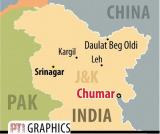
The Chinese troops started their incursion in the Chumar area on the evening of July 16 and they remained in the Indian area till the morning of July 17, sources said.
Army sources confirmed the incursion saying that Indian troops had intercepted the PLA patrol in the Chumar area and after the usual banner drill between the two sides, the PLA patrol went back into their territory.
Sources said the intruding Chinese soldiers asked the Indian soldiers to vacate the area claiming that they were standing in Chinese territory.
The incursion by Chinese land forces comes soon after its two helicopters violated Indian air space on July 11 in the Chumar sector.
In the same area, PLA troops had intruded and taken away an Indian surveillance camera on June 17.
The latest incursion took place on the day when India gave approval to the creation of a 50,000-strong Mountain Strike Corps along the border with China.
The frequency of such incidents increased around the time Defence Minister A K Antony went to China earlier this month and the two countries discussed measures to enhance peace and tranquillity along the Line of Actual Control between them.
Chumar, located 300km from Leh, has always been an area of discomfort for the Chinese troops as this is the only area along the China-India border where they do not have any direct access to the LAC.
India and China have been working towards signing a border pact to maintain peace and tranquillity along the LAC where a number of incursion incidents have been observed in recent months.





Comments
Add new comment